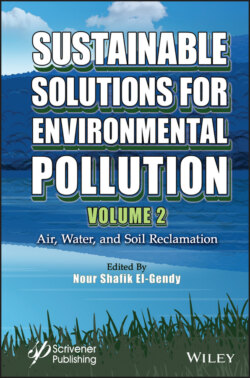Читать книгу Sustainable Solutions for Environmental Pollution, Volume 2 - Группа авторов - Страница 34
1.8.1 Carbon and Nutrients (N and P) Removal
ОглавлениеThe photosynthetic capabilities of algae are particularly attractive, converting solar energy into useful biomass while incorporating mineral nutrients including nitrogen and phosphorus (Zhou, 2014). According to Ruiz-Martinez et al. (2012) a mixture of the microalgae Chlorococcales and cyanobacteria isolated from a submerged anaerobic bioreactor reduced N-NH4 by 62% and P-PO4 to 97% after a 42 day culturing period in WWTP effluent (Ruiz-Martinez et al., 2012). In a study by Silva-Benavides and Torzillo (2011), the authors compare the removal efficiency of Chlorella and a Chlorella-Planktothrix co-culture grown in municipal wastewater. The co-culture of Chlorella-Planktothrix removed the highest nitrogen concentration (80%) over the 2-day exposure period (Silva-Benavides and Torzillo, 2012).
Oberholster et al. (2019) demonstrated the effectiveness of nutrient removal from domestic wastewater by mass inoculating specifically selected strains of algae (Chlorella spp.) into the maturation ponds of a sewage treatment plant. The total phosphorus (Ptot) reduction in the water was 74.7% and 76.4%, and the total nitrogen (Ntot) reduction was 43.1% and 35.1%, in the last two maturation ponds. For maximum treatment results, the algae biomass in the upper surface water layer must be harvested (Oberholster et al., 2019).
Chlorella spp., such as Chlorella sorokiniana and Chlorella vulgaris, are especially popular due their ability to efficiently remove nitrogen and phosphorous from effluents (Hernandez et al., 2006). The large-scale use of algae is mainly due to a good understanding of large-scale culture systems as such systems are used to produce highly valued products including pharmaceuticals and genetically engineered products (Shahid et al., 2020a). Diatoms are microalgae rich in silica and with a higher photosynthetic activity than green algae: they develop either as single cells or embedded in colonies (biofilms) fixed on any surface (including plants) in fresh and saline waters. They are also good candidates for metal removal (Marella et al., 2020).
Nitrogen removal in CWs occurs in a two-step process: nitrification and denitrification. Ammonia-oxidizing bacteria and nitriteoxidizing bacteria convert total ammonia to nitrate. In contrast, in anoxic environment, denitrifiers reduce nitrate and nitrite into nitrogen gas. Microalgae releases oxygen, creating a favorable environment for the oxidation of nitrogen. In addition to oxygen-carbon dioxide exchange, interactions between microalgae and bacteria also include other aspects such as nutrient cycling, growth promotion and EPS production. This indicates the important role the microalgae-bacteria consortia play in the wastewater treatment processes (Chindah et al., 2007; Cho et al., 2015).
